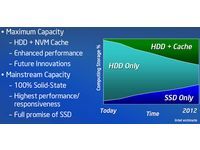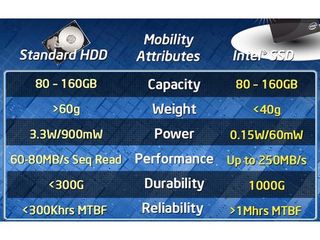Intel's X25-M Solid State Drive Reviewed
Intel’s SSD Plans

Intel introduced its flash disk product line at IDF in August 2008; now we’re seeing the first product sample. The firm intends to release mainstream products based on affordable MLC flash technology first at 80 GB capacity, offering both 2.5” and 1.8” form factor standards using the SATA/300 interface. The 1.8” version is based on micro SATA. Higher capacity versions at 160 GB will follow later, as well as the high-speed X25-E at 32 GB and 64 GB. These professional drives will be based on SLC flash, and while the MLC-based X25-M reviewed today should appear at retail in October, the SLC version X25-E won’t be available before the end of the year.

The fact that there are several SSD products scheduled for 2009 makes it clear that Intel intends to traverse the storage path on a mission. Next year will see a shrink from 50 nm to 34 nm, which we expect will double storage densities. The roadmap talks about 160+ GB for the MLC devices and 64+ GB for the SLC models.
Intel expects the disk drive market to be shrinking in favor of flash-based or flash-assisted solutions, which isn’t really surprising: flash memory is on the brink of replacing conventional hard drives in high-end servers, where transaction performance and I/O capabilities count most, and in the lowest end, where 8 GB to 32 GB flash is smaller, more robust and more affordable than any hard drive. But as soon as capacity is required, flash drives don’t stand a chance, and they will continue to cost considerably more per gigabyte.

Intel sees a massive future for hard drives that come with an additional cache memory—so-called hybrid hard drives (H-HDDs). Unfortunately, we haven’t seen any new hybrid drives since their first appearance in mid-2007, so we’re curious to see what the future might still bring. It does make sense, but the first implementations could deliver neither improved battery life nor improved performance.
Roughly 30% flash-based drives by 2012 still seems optimistic, but these numbers may include an increasing number of netbooks and low-cost PCs for emerging countries, which will for sure only be equipped with low-cost flash storage.

Although the new X25-M drive is targeted at the mainstream, we found that it will be highly attractive even for enterprise environments, just because the Intel flash SSDs are extremely dominant when it comes to I/O performance. Click the image on the right to look at Intel’s comparison between hard drives and flash SSDs when 120 drives are used in an enterprise environment. Although it’s heavily biased towards flash drives (SAS hard drives provide much more than the shown 100 MB/s throughput), it makes a good point: flash SSD arrays offer better throughput, around 20x to 100x better I/O performance and they only require a fraction of the energy to deliver this performance. We’ll look into this in our benchmark section as well.
Stay on the Cutting Edge
Join the experts who read Tom's Hardware for the inside track on enthusiast PC tech news — and have for over 25 years. We'll send breaking news and in-depth reviews of CPUs, GPUs, AI, maker hardware and more straight to your inbox.
Current page: Intel’s SSD Plans
Prev Page Intel’s First Flash SSD Ready for Vertical Take-Off Next Page Intel X25-M SSD: Better by Design?Most Popular

